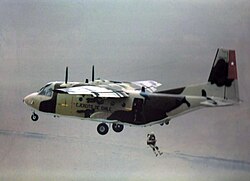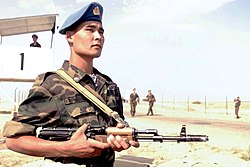This article may contain excessive or inappropriate references to self-published sources .(March 2024) |
Many countries around the world maintain military units that are trained as paratroopers. These include special forces units that are parachute-trained, as well as non-airborne forces units.
Contents
- Abkhazia
- Albania
- Algeria
- Angola
- Argentina
- Armenia
- Australia
- Austria
- Azerbaijan
- Bahrain
- Bangladesh
- Belarus
- Belgium
- Benin
- Bolivia
- Botswana
- Brazil
- Brunei
- Bulgaria
- Burkina Faso
- Burundi
- Cambodia
- Cameroon
- Canada
- Chile
- China (People’s Republic of China)
- Taiwan (Republic of China)
- Colombia
- Congo-Brazzaville (Republic of Congo)
- Congo-Kinshasa (Democratic Republic of Congo)
- Croatia
- Cuba
- Cyprus (Republic of Cyprus)
- Cyprus (Turkish Republic of Northern Cyprus)
- Czech Republic
- Denmark
- Djibouti
- Dominican Republic
- Ecuador
- Egypt
- El Salvador
- Estonia
- Eswatini (Swaziland)
- Ethiopia
- Fiji
- Finland
- France
- Gabon
- Georgia
- Germany
- Ghana
- Greece
- Guatemala
- Guinea
- Guyana
- Honduras
- Hungary
- India
- Indonesia
- Iran
- Ireland
- Israel
- Italy
- Ivory Coast
- Japan
- Jordan
- Kazakhstan
- Kenya
- Korea (Democratic People’s Republic of Korea/“North Korea”)
- Korea (Republic of Korea/“South Korea”)
- Kuwait
- Kyrgyzstan
- Latvia
- Lesotho
- Lithuania
- Macedonia (Republic of North Macedonia)
- Madagascar
- Malawi
- Malaysia
- Maldives
- Mali
- Mauritania
- Mexico
- Moldova
- Mongolia
- Montenegro
- Morocco
- Myanmar
- Namibia
- Nepal
- Netherlands
- New Zealand
- Nicaragua
- Niger
- Nigeria
- Norway
- Oman
- Pakistan
- Paraguay
- Peru
- Philippines
- Poland
- Portugal
- Qatar
- Romania
- Russian Federation
- Rwanda
- Saudi Arabia
- Senegal
- Serbia
- Seychelles
- Singapore
- Slovakia
- Slovenia
- South Africa
- South Ossetia
- Spain
- Sri Lanka
- Sudan
- Suriname
- Sweden
- Switzerland
- Tajikistan
- Tanzania
- Thailand
- Togo
- Tunisia
- Turkey
- Turkmenistan
- Uganda
- Ukraine
- United Arab Emirates
- United Kingdom
- United States
- Uruguay
- Uzbekistan
- Venezuela
- Vietnam
- Zambia
- Zimbabwe
- See also
- References







































